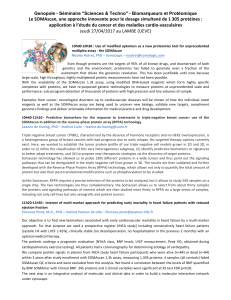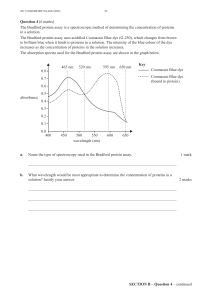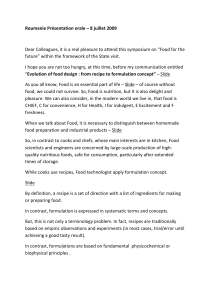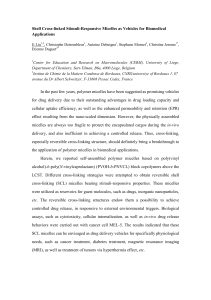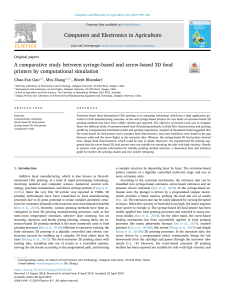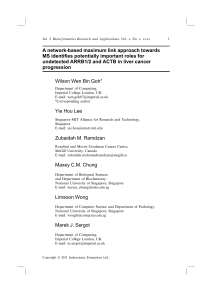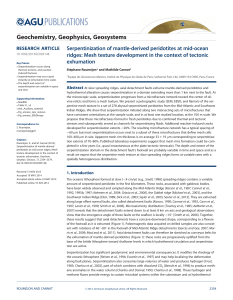Macro Materials Eng - 2010 - Verbeek - Extrusion Processing and Properties of Protein‐Based Thermoplastics
publicité
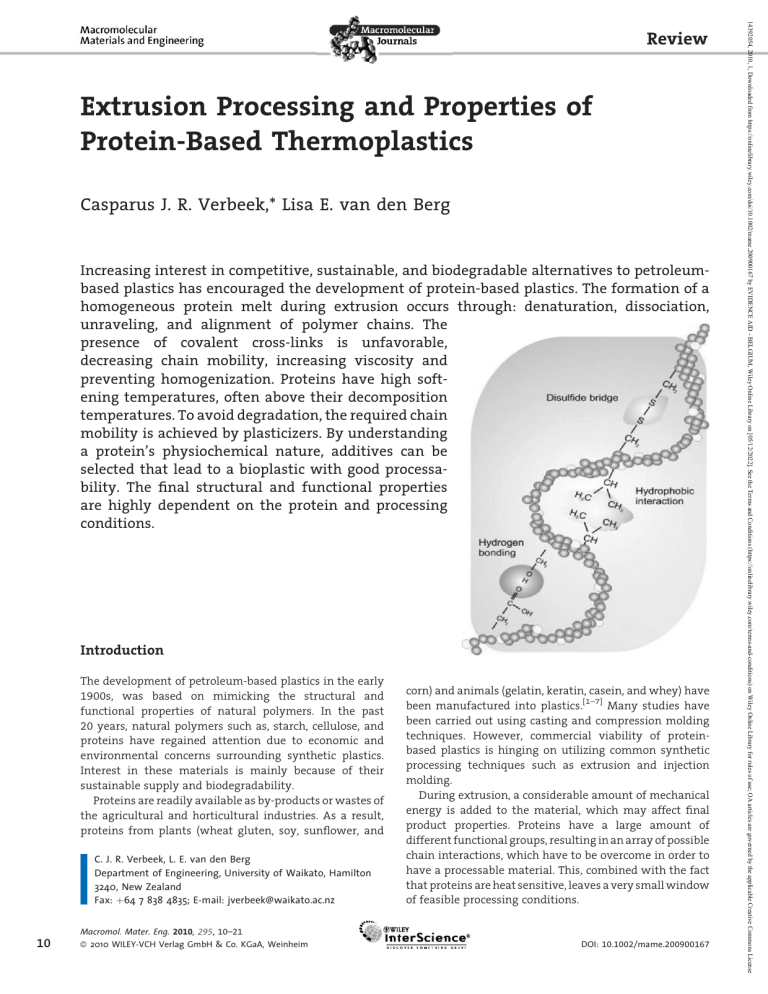
Extrusion Processing and Properties of Protein-Based Thermoplastics Casparus J. R. Verbeek,* Lisa E. van den Berg Increasing interest in competitive, sustainable, and biodegradable alternatives to petroleumbased plastics has encouraged the development of protein-based plastics. The formation of a homogeneous protein melt during extrusion occurs through: denaturation, dissociation, unraveling, and alignment of polymer chains. The presence of covalent cross-links is unfavorable, decreasing chain mobility, increasing viscosity and preventing homogenization. Proteins have high softening temperatures, often above their decomposition temperatures. To avoid degradation, the required chain mobility is achieved by plasticizers. By understanding a protein’s physiochemical nature, additives can be selected that lead to a bioplastic with good processability. The final structural and functional properties are highly dependent on the protein and processing conditions. Introduction The development of petroleum-based plastics in the early 1900s, was based on mimicking the structural and functional properties of natural polymers. In the past 20 years, natural polymers such as, starch, cellulose, and proteins have regained attention due to economic and environmental concerns surrounding synthetic plastics. Interest in these materials is mainly because of their sustainable supply and biodegradability. Proteins are readily available as by-products or wastes of the agricultural and horticultural industries. As a result, proteins from plants (wheat gluten, soy, sunflower, and C. J. R. Verbeek, L. E. van den Berg Department of Engineering, University of Waikato, Hamilton 3240, New Zealand Fax: þ64 7 838 4835; E-mail: [email protected] 10 Macromol. Mater. Eng. 2010, 295, 10–21 ß 2010 WILEY-VCH Verlag GmbH & Co. KGaA, Weinheim corn) and animals (gelatin, keratin, casein, and whey) have been manufactured into plastics.[1–7] Many studies have been carried out using casting and compression molding techniques. However, commercial viability of proteinbased plastics is hinging on utilizing common synthetic processing techniques such as extrusion and injection molding. During extrusion, a considerable amount of mechanical energy is added to the material, which may affect final product properties. Proteins have a large amount of different functional groups, resulting in an array of possible chain interactions, which have to be overcome in order to have a processable material. This, combined with the fact that proteins are heat sensitive, leaves a very small window of feasible processing conditions. DOI: 10.1002/mame.200900167 14392054, 2010, 1, Downloaded from https://onlinelibrary.wiley.com/doi/10.1002/mame.200900167 by EVIDENCE AID - BELGIUM, Wiley Online Library on [05/12/2022]. See the Terms and Conditions (https://onlinelibrary.wiley.com/terms-and-conditions) on Wiley Online Library for rules of use; OA articles are governed by the applicable Creative Commons License Review The objective of this study is to review available literature on thermoplastic extrusion and to identify critical factors that influence processing and the final properties of proteinous plastics, more specifically: i. Structure/processing relationships, including processing conditions and visco-elasticity. ii. Material properties before and after processing with reference to protein conformation. Proteins Proteins and petroleum-based polymers share some vital characteristics. A synthetic polymer consists of identical monomers, covalently bonded in a long chain. Proteins are also composed of repeating units, but may contain up to 20 different amino acid monomers forming a polypeptide chain.[8] The amino acid repeat unit contains two carbon atoms as well as nitrogen, differing only in their functional side groups. In its natural environment, a protein will be folded into secondary, tertiary, and quaternary structures stabilized through hydrophobic interact ions, hydrogen bonding, and electrostatic interactions between amino acid functional groups. Once folded, the structure may be stabilized further, with strong covalent cross-links. The amino acid sequence will define the final properties of the polymer, such as the proportion of various secondary structures, hydrophobicity, cross-link density, and rigidity. The large number of possible amino acid sequences adds to the complex nature of these heteropolymers. Table 1 shows the amino acid contents of proteins and protein blends that have been used to produce bioplastics. Each protein source has different amino acid content and will react to plastic processing conditions differently. For example, proteins or protein blends containing a relatively large proportion proline and hydroxyproline may be less ordered because of the disruptive effect of these amino acid residues on typical secondary structures. It has been thought that this disruptive effect causes the protein to be more disordered, thereby behaving slightly more like a synthetic polymer during processing.[9] A protein-based material could be defined as a threedimensional macromolecular network, stabilized and strengthened by hydrogen bonds, hydrophobic interactions, and disulfide bonds.[10] Globular proteins are required to unfold and realign before a new three-dimensional network can be formed, and stabilized by new inter- and intra-molecular interactions.[7,11–13] Protein-based bioplastics are manufactured using the process of denaturation, induced by thermal or chemical means.[12] The denaturation temperature of proteins depends on the amino acid Macromol. Mater. Eng. 2010, 295, 10–21 ß 2010 WILEY-VCH Verlag GmbH & Co. KGaA, Weinheim Johan Verbeek is a Senior Lecturer at the University of Waikato in Hamilton, New Zealand. He holds a PhD in Chemical Engineering and is working on polymers and polymer composites as part of the Composites Research Group at the University of Waikato, focusing on using renewable and waste materials to produce polymeric composites. His main interest is in filled and functionally filled polymers, polymer modification, and reactive extrusion as well as modeling mechanical properties of polymer composites. In 2008, he received the Bayer/ National Business Review Innovators Award in the Agricultural and Environment category for his contribution to the development of second generation bioplastics. Lisa van den Berg is a Technology Development Analyst at Waikato Link Ltd. in Hamilton, New Zealand, the commercialization and technologytransfer company of the University of Waikato. Lisa crosses the scientific businesses, acting in a biotechnology and scientific advisory role in the commercialization office. She holds a Masters of Science (MSc) in Biotechnology from the University of Waikato where she conducted research on developing second generation proteinous bioplastics from meat industry byproducts. Lisa is very interested in all aspects of biotechnology, especially protein-based and related technologies. sequence, the type of chemical additives used, and processing method employed.[12] Due to the diverse building blocks of proteins and their unique structure, a large variety of biodegradable materials can be produced, offering a wide range of functional properties.[14] Proteinous biopolymers are often blends of various proteins, each with its unique properties; however, the significance of this has not been widely explored. Two processes have been developed to produce proteinbased materials: wet processing and dry processing.[5,7,12] The wet process, or casting, involves dispersing and solubilizing the protein in large quantities of solvent followed by solvent removal by drying.[7] The dry process involves mixing the proteins and appropriate additives, under low moisture conditions, followed by thermomechanical shaping using compression molding, extrusion, or injection molding.[7] In recent years, the majority of research has been focused on casting and thermo-molding. However, extrusion and injection molding are widely accepted, processing techniques in the plastics industry and would favor the acceptance of protein-based bioplastics, if it can be used for bioplastic processing. www.mme-journal.de 11 14392054, 2010, 1, Downloaded from https://onlinelibrary.wiley.com/doi/10.1002/mame.200900167 by EVIDENCE AID - BELGIUM, Wiley Online Library on [05/12/2022]. See the Terms and Conditions (https://onlinelibrary.wiley.com/terms-and-conditions) on Wiley Online Library for rules of use; OA articles are governed by the applicable Creative Commons License Extrusion Processing and Properties of Protein-Based . . . Table 1. Amino acid contents of some protein sources used for bioplastics. Amino acid Amino acid content mol-% Egg white Whey Casein Gelatin Soy CGM Wheat gluten Valine 7.00 6.00 6.60 2.20 5.00 4.60 4.10 Leucine 8.50 9.50 9.00 3.30 8.10 14.50 6.80 Isoleucine 6.00 6.00 5.10 1.50 4.80 3.50 4.00 Phenylalanine 6.00 2.30 5.10 2.40 5.20 4.40 4.90 Methionine 3.60 1.90 2.70 0.70 1.30 2.20 1.80 Tryptophan 1.40 2.20 1.30 1.30 0.30 1.00 Alanine 6.60 5.20 2.90 8.90 4.20 11.50 2.40 Proline 3.80 6.60 10.70 24.30 5.10 9.60 13.70 Cysteine 2.50 2.20 0.30 1.30 1.70 2.10 Glycine 3.60 2.20 2.10 4.10 4.10 3.10 Non-polar 21.40 Polar Serine 7.30 5.40 5.60 3.60 5.20 5.50 5.20 Threonine 4.40 6.90 4.30 2.10 3.80 3.80 2.50 Tyrosine 2.70 2.70 5.60 0.50 3.80 3.40 3.80 Glutamic acid 13.50 16.80 21.50 10.00 19.00 20.30 37.30 Aspartic acid 8.90 10.90 6.60 6.00 11.50 5.50 2.90 6.20 8.80 3.80 4.50 6.20 1.40 1.20 Acidic residues Basic residues Lysine Arginine 5.60 2.50 3.70 7.80 7.50 2.20 2.40 Histidine 2.20 2.00 3.00 0.80 2.60 1.50 2.20 Ref. [15] [15] [15] [16] [15] [17] [18] Structure/Processing Relationships Effective and efficient extrusion technology has been widely used to process polymers. An extruder consists of a heated, fixed metal barrel that contains either one or two screws which convey the raw material from the feed end of the barrel to the die. The screws act by conveying the material through the heated barrel, inducing shear forces and increasing pressure along the barrel. Process variables include the feed material’s composition, screw speed, barrel temperature profile, feed rates, and die size and shape. The degree of screw fill, specific mechanical energy (SME) input, torque, pressure at the die, residence time, and product temperature are influenced by these process variables. Both single- and twin-screw extruders have been used successfully in producing protein-based materials.[20,22,38,48,61] However, twin-screw extruders convey the material through positive displacement rather than 12 Macromol. Mater. Eng. 2010, 295, 10–21 ß 2010 WILEY-VCH Verlag GmbH & Co. KGaA, Weinheim friction forces, offering more efficient mixing and conveying, which is often a requirement during bioplastic compounding. Extrusion requires the formation of a protein melt, implying processing above the protein’s softening point. Proteins contain a vast range of inter-molecular interactions that reduce molecular mobility and increase viscosity, resulting in a high softening temperature, often above the decomposition temperature. To avoid degradation, additives that can alter the softening point are required for successful thermoplastic extrusion of proteins. Processing Conditions Temperature During extrusion, equilibrium is established between protein de-aggregation due to mechanical stress and aggregation from heating.[19–21] In the metering zone, heat DOI: 10.1002/mame.200900167 14392054, 2010, 1, Downloaded from https://onlinelibrary.wiley.com/doi/10.1002/mame.200900167 by EVIDENCE AID - BELGIUM, Wiley Online Library on [05/12/2022]. See the Terms and Conditions (https://onlinelibrary.wiley.com/terms-and-conditions) on Wiley Online Library for rules of use; OA articles are governed by the applicable Creative Commons License C. J. R. Verbeek, L. E. van den Berg is supplied by external heating elements, as well as by viscous heat dissipation. Excessive aggregation at high temperatures will result in physical cross-linking, reducing melt flow. The heat supplied during processing is therefore an important parameter for protein extrusion. The effect of different barrel and die temperatures on the extrusion of feather keratin, glycerol, water, and sodium sulfite blends was studied by Barone et al.[22] Barrel temperature profiles of 100/100/100 8C and 120/120/ 120 8C, with die temperatures of 120 or 140 8C, were used.[22] Using lower barrel and die temperatures, resulted in polymer softening just before the die, leading to high viscosities.[22] Higher barrel temperatures had a lower apparent viscosity, and the material softened earlier inside the barrel.[22] Unfortunately, a temperature profile that induces formation of the melt early in the barrel can cause extensive aggregation before exiting the die. Thermoplastic extrusion of proteins requires the majority of reactions to occur just before, or just after exiting the die. The polymer melt is required to withstand the induced strain upon exiting the die which is hindered by cross-linking, leading to a disruption of the extrudate upon exiting. Specific Mechanical Energy Input The SME input is a measure of the severity of extrusion conditions and is calculated using torque, screw speed, and mass flow rate [Equation (1)]. It has a direct impact on the rheological properties of the melt, the extent of macromolecular transformations, and interactions between additives, resulting in polymers that could range from partially soluble to insoluble, expanded, or even degraded.[5] SMEðkJ=kgÞ ¼ torque screw speed mass flow rate (1) Redl et al.[20] studied the effect of extrusion processing conditions on glycerol-plasticized wheat gluten. The influence of feed rate, screw speed, and barrel temperature was investigated. Depending on the operating conditions, smooth-surfaced extrudates with high swell or completely disrupted extrudates were obtained. The SME and maximum temperature of the product were found to have the largest influence on the final extrudate properties. Disrupted extrudates resulted from excessive cross-linking, brought about by high SME and product temperatures. It was shown that low SME input is required for effective extrusion, mainly to prevent excessive cross-linking. Pommet et al.[23] studied the influence of mixing, on the thermoplastic behavior of wheat gluten, using extrusion, batch mixing, and compression molding. The insoluble fraction was measured for each product. Increased insolubility was observed in disrupted extrudates, confirming Macromol. Mater. Eng. 2010, 295, 10–21 ß 2010 WILEY-VCH Verlag GmbH & Co. KGaA, Weinheim that high SME and high temperatures resulted in excessive cross-linking. It was found that the activation energy for cross-linking during compression molding and batch mixing were 170 and 33.7 kJ mol1 respectively. It can therefore be seen that shear significantly lowers the activation energy for cross-linking and would lead to excessive cross-linking if the processing temperature is not adjusted accordingly. These results were confirmed using gluten/glycerol blends processed in a thermostatted counter-rotating batch mixer.[21] The authors confirmed that increased cross-linking occurred above 60 8C and that the added shear reduced the activation energy of gluten cross-linking.[21] Otaigbe et al.[24] studied the shear deformation and flow behavior of soy protein isolate-corn starch plastics using torque rheometry. At a typical processing temperature of 120 8C, the soy protein plastic showed shear thinning. At high shear rates, temperature and torque increased significantly, attributed to shear-induced heating. The high temperatures are believed to induce thermal degradation and/or cross-linking. Control of protein/protein interactions that occur during extrusion is required for successful processing. Heating promotes network formations through association of polymer chains thought to be driven by hydrophobic interactions, and stabilized by disulfide bonds.[20,25–29] The formation of dense associations and cross-links inside the extruder barrel causes an increase in viscosity and a reduction in chain mobility. As a result, residence time, torque, and pressure in the metering zone will increase and may result in protein degradation. Plasticizers and other chemical additives can successfully be employed to reduce macromolecular associations during extrusion, leading to improved processability and ultimate material properties. Chemical Additives The formation of covalent cross-linking during extrusion will inhibit the formation of a thermoplastic material. Instead, extensive cross-linking (>10%), can result in the formation of a thermoset material, which cannot be remolded or reshaped. A thermoset will cause the extruder to fail, rising the torque and pressure above operative maximums. To produce a thermoplastic material from proteins, crosslinking and non-covalent interactions have to be controlled. Barone et al.[22] extruded poultry feathers (which contain keratin), with a combination of glycerol, water, and sodium sulfite as processing aids. Keratins are characterized by a large amount of cysteine. Cystine-cystine cross-links (disulfide bridges) provide strength and stiffness to keratin in the solid-state. However, they are an impediment to processing in the melt-state.[22] With the use of a reducing www.mme-journal.de 13 14392054, 2010, 1, Downloaded from https://onlinelibrary.wiley.com/doi/10.1002/mame.200900167 by EVIDENCE AID - BELGIUM, Wiley Online Library on [05/12/2022]. See the Terms and Conditions (https://onlinelibrary.wiley.com/terms-and-conditions) on Wiley Online Library for rules of use; OA articles are governed by the applicable Creative Commons License Extrusion Processing and Properties of Protein-Based . . . agent, such as sodium sulfite, these cross-links can be broken, greatly improving processability. It was shown that the apparent viscosity during extrusion, decreased with increasing sodium sulfite up to 3 wt.-%, after which it increased with the addition of more sodium sulfite. It was hypothesized that the increase in viscosity after 3 wt.-% was due to increased chain mobility and entanglements after the complete reduction of disulfide bonds. It was found that protein chain mobility was sufficient above 4 wt.-% sodium sulfite, to allow chains to be orientated into crystalline structures, as revealed by NMR spectroscopy.[22] Orliac et al., investigated the rheological behavior of sunflower protein isolate (SFPI) processed with water, glycerol, and in some cases sodium sulfite. It was shown that sodium sulfite can be used to reduce the required amount of plasticizer for thermoplastic extrusion. An initial decrease in viscosity was observed, followed by an increase upon further addition of sodium sulfite. It was concluded that greater protein unfolding at higher sodium sulfite concentrations, led to a more extended structure after processing.[30] Ralston and Osswald[31] used a screw-driven capillary rheometer to measure the viscosities of soy protein isolates extruded with cornstarch, glycerol, sodium sulfite, deionized water, and soy oil. In the absence of sodium sulfite, disulfide bonds reduced the effective chain length and led to a more globular protein conformation.[31] Soy protein does not have extensive cross-links, and processing is therefore not hugely influenced by the addition of sodium sulfite. However, it was found that the use of sodium sulfite increased consolidation by enabling chain movement. This will lead to exposure of functional groups capable of forming new interactions. The viscosity of a polymer melt depends on protein composition. Covalent cross-links are not always the inhibiting factor. Water insoluble and hydrophobic proteins, such as zein, require the addition of surfactants to enable thermoplastic processing. Sodium dodecyl sulfate (SDS) is an amphiphilic molecule, capable of electrostatic and hydrophobic interactions, causing dissociation of protein chains. Many studies of protein-based plastics formed by cast and compression molding have used SDS for added denaturation and dissociation, thereby improving processing.[32–38] Sessa et al.[38] studied the viscosity of zein during torque rheometry. Known amounts of water, triethylene glycol (TEG), and SDS were added in order to control viscosity. The addition of water resulted in a rapid torque rise after 1 min. Further addition of TEG and SDS delayed the rise by up to 12 min. They postulated that at a certain temperature and shear, zein denatures and forms entanglements and aggregates leading to a rapid increase in torque. It was concluded that the reduction in intermolecular forces, 14 Macromol. Mater. Eng. 2010, 295, 10–21 ß 2010 WILEY-VCH Verlag GmbH & Co. KGaA, Weinheim brought about by the presence of SDS, slowed the rate of aggregation induced by processing.[38] Urea can be used to denature a protein molecule, and is extensively used in proteomics.[39] It forms hydrogen bonds with amino acids, thereby preventing protein-protein interactions. The majority of bioplastic research using urea, has used compression molding as a processing technique. Mo and Sun[40] investigated the thermal and mechanical properties of plastics molded from ureamodified soy protein isolates. Urea increased the degree of denaturation of soy protein and the glass transition temperature (Tg) decreased with increasing urea concentration, but mechanical properties reached a maximum value at 8 mol L1. At low concentration (X < 2 mol L1), urea functioned as a plasticizer, while at high concentrations (X > 4 mol L1) it acted as plasticizer, cross-linking agent, and filler. At high concentrations, urea can form a surface residue after long-term storage. Pommet et al.[19] used 30 wt.-% urea in wheat gluten and Mo and Sun[41] investigated the effect of storage time on urea-modified soy protein, both observing the formation of urea on the surface of the material overtime. This shows that protein-protein interactions are stronger than urea-protein interactions, forcing the urea out of the material overtime.[41] Compared to polyol plasticizers, urea is not as flexible and the plasticized materials do not show the same extensibility. Therefore urea is good as a denaturant, to increase chain mobility during processing. The use of a stronger plasticizer may further reduce strong protein-protein interactions which could enhance urea diffusion to the surface. Visco-Elasticity Denaturation and therefore chain mobility, is essential for successful extrusion. Proteins are semi-crystalline polymers and undergo several thermal transitions, similar to synthetic polymers. The most common techniques used to measure the glass transition temperature of polymers include differential scanning calorimetry (DSC) and dynamic mechanical thermal analysis (DMTA). The glass transition appears as a step in the DSC baseline, resulting from a change in heat capacity (enthalpy). DMTA measures the change in viscoelastic properties of the polymer with changing temperature.[43] The glass transition temperature is interpreted from the storage and loss moduli data obtained from a DMTA run. Thermal transitions are related to chain mobility, most important of which is the glass transition (Tg) which is associated with the onset of main chain motions (Figure 1).[9] It is the primary structure of a protein that determines its tendency toward cross-linking, as well as its sensitivity toward plasticization, or chain mobility.[33,72] Secondary transitions (short range motions) have also DOI: 10.1002/mame.200900167 14392054, 2010, 1, Downloaded from https://onlinelibrary.wiley.com/doi/10.1002/mame.200900167 by EVIDENCE AID - BELGIUM, Wiley Online Library on [05/12/2022]. See the Terms and Conditions (https://onlinelibrary.wiley.com/terms-and-conditions) on Wiley Online Library for rules of use; OA articles are governed by the applicable Creative Commons License C. J. R. Verbeek, L. E. van den Berg Figure 1. General change in storage modulus with temperature of protein and synthetic polymers.[9,33,42,43] known to occur at lower temperatures, but do not influence the main rheological responses of proteinous biopolymers.[9] Processing temperature is a critical parameter for protein extrusion. Mobility of the polymer increase with increase in temperature, but hydrophobic interactions and aggregation which follows denaturation will restrict chain movement.[29] The glass transition temperature of proteins varies based on protein source (primary structure), thermal history and additives. Increasing the molecular mass, chain stiffness or intermolecular forces will decrease the molecular mobility, therefore increasing the Tg (Figure 1). Most synthetic plastics have a Tg below 100 8C, whereas proteins with less than 5% water show glass transition temperatures close to or above their decomposition temperatures (Table 2).[44] Above the Tg, further heating to above the softening point (or flow temperature, Tf) results in a low viscosity material, which can easily be processed. It previously been shown that the difference between Tg – Tf for casein, soy and gluten-based biopolymers are in the order of 40 8C.[9] Consequently, the use of plasticizers or other additives to increase chain mobility has become essential to prevent protein degradation and increasing processability.[47] Figure 2 illustrates how plasticization and heating above a material’s glass transition and softening point will allow it to become shaped into a marketable product; plasticization reduces both Tg and softening point and when the Table 2. Glass transition temperatures of dry proteins. Protein Source Tg Ref. -C Feather keratin 238 [45] Wheat gluten 162 [5,9,45,46] Soy 172 [9] Corn gluten meal 178 [17] Macromol. Mater. Eng. 2010, 295, 10–21 ß 2010 WILEY-VCH Verlag GmbH & Co. KGaA, Weinheim Figure 2. Schematic representation of the thermoplastic process applied to protein-based materials.[7] softening point is below the decomposition temperature, the material should be easily processable. Plasticizers improve processability by interposing themselves between the polymer chains and alter the forces holding the chains together.[17] This occurs through two mechanisms, lubrication and increasing free volume. Small molecules are easily incorporated into the protein matrix, shown by the high plasticizing effect of water and glycerol.[17,43] Water is considered a natural plasticizer of proteins and is used extensively in protein extrusion. Its small size allows it to easily maneuver through small openings between chains. When plasticizers are compared based on the mass fraction in a bioplastic, low molecular mass compounds such as water, will be present at larger numbers compared to high molecular mass compounds. Every plasticizer molecule can interact with a protein chain, which implies that at equal mass fractions, water is normally more efficient than other plasticizers. Hydrophilic compounds such as polyols, carbohydrates and amines also interact with polar amino acids. Some examples are glycerol, sorbitol, saccharose, urea, TEG and polyethylene glycol. Other substances such as, amphiphilic plasticizers will interact with the hydrophobic amino acids within the protein, examples include fatty acids and phthalates and some surfactants.[48] Plasticizers are added to proteins to reduce their processing temperature, by increasing molecular mobility and decreasing viscosity. Plasticizers act by reducing hydrogen bonding, van der Waals, or ionic interactions that hold polymer chains together, through forming plasticizer-polymer interactions. Sufficient plasticization will reduce the SME input, resulting in less disrupted and better quality products.[5] Polar Compounds as Plasticizers The effect of moisture content on the glass transition temperature has been extensively studied.[9,12,17,25,46,49–55] Water reduces the glass transition temperature and reduces www.mme-journal.de 15 14392054, 2010, 1, Downloaded from https://onlinelibrary.wiley.com/doi/10.1002/mame.200900167 by EVIDENCE AID - BELGIUM, Wiley Online Library on [05/12/2022]. See the Terms and Conditions (https://onlinelibrary.wiley.com/terms-and-conditions) on Wiley Online Library for rules of use; OA articles are governed by the applicable Creative Commons License Extrusion Processing and Properties of Protein-Based . . . Table 3. Water effect on glass transition temperature of various protein sources. Protein source Tg at percentage Water Analysis technique Ref. -C a) 0 5 10 15 20 25 30 CGMa) 178 100 70 55 45 40 30 Zein 139 70 40 10 <0 Casein 210 140 90 70 50 40 25 Soya 172 105 80 60 45 35 35 Wheat gluten 162 110 65 40 20 18 <18 [17] DSC [49] DMTA, PTAc), DSC [9] Corn gluten meal; b)Modulated DSC; c)Pulse thermal analysis. the temperature at which secondary interactions between protein chains form. During extrusion, water acts as a dispersion medium, plasticizer and solvent, influencing melting and viscosity of the extrudate and the deformation of dispersed particles.[44] Water has a low molecular mass and very low Tg (135 8C), making it a very efficient plasticizer for proteins. In Table 3 the effect of moisture content on the Tg of various protein bioplastics are shown. It can be seen that only a small amount is required to bring about a large reduction in Tg. Water enters the protein network and interacts with protein chains by hydrogen bonding with easily accessible polar amino acid side chains, preventing protein-protein interactions and thereby leading to plasticization. Another very common plasticizer for proteins is glycerol. Small and water soluble, it shows a similar plasticizing effect as water, easily penetrating the folded protein’s surface to interact with polar amino acids.[17] The most important difference between glycerol and water is glycerol’s higher viscosity, which has been shown to induce viscous heat dissipation during mixing of wheat gluten.[19] Hernandez-Izquierdo et al.[47] also found that during extrusion of whey protein, water, and glycerol mixtures, higher glycerol contents induced viscous heat dissipation and higher SME requirements. Glycerol and water are effective plasticizers, due to their low molecular mass and ability to interact with polar residues. However, studies have observed plasticizer migration during storage of protein-based plastics.[56] In dry conditions, unbound water evaporates readily over time, reducing its plasticizing effect.[30,57–59] Low permanence of a plasticizer in the product is very important ensuring consistent properties as to when it was produced. 16 MDSCb) with the hydrophobic areas in the polypeptide chain. Hydrophobic areas will only be able to interact with each other, and not with the polar plasticizer, forming densely packed structural domains.[44] Amphiphilic plasticizers have a similar chemical makeup to proteins, containing both polar and non-polar groups. Proteins are stabilized mainly by hydrogen bonds, but hydrophobic interactions also play an important role. Di Gioia and Guilbert[17] studied the efficiencies of polar and amphiphilic plasticizers in reducing the Tg of corn-glutenmeal (CGM). The Tg for dry CGM was found to be above 150 8C. The plasticizing efficiency, based on decreasing the Tg, was compared on the basis of volume and molar fraction of plasticizer, theoretical hydrogen bonds supplied by the plasticizer (TH) and percentage hydrophilic groups of the plasticizer (%HG) (Table 4). CGM has approximately Table 4. Physiochemical characteristics of plasticizers.[17,19] Plasticizer Molecular Hydrogen Hydrophilic mass bonds groups g mol1 % Water 18 4 100.0 Sorbitol 182 18 56.0 Lactic acid 90 8 55.6 Glycerol 92 9 55.4 Ethylene glycol 62 6 54.8 Diethylene glycol 106 8 47.2 Propylene glycol 76 6 44.7 TEG 150 10 44.0 1,4-butanediol 90 6 37.8 Other Plasticizers Dibutyl tartate 262 14 37.4 General consensus is that hydrophobic interactions govern the associations of protein chains during extrusion. Polar plasticizers, like glycerol and water, are unable to interact Dibutyl phthalate 278 4 23.5 Octanoic acid 144 5 22.9 Palmitic acid 256 5 12.9 Macromol. Mater. Eng. 2010, 295, 10–21 ß 2010 WILEY-VCH Verlag GmbH & Co. KGaA, Weinheim DOI: 10.1002/mame.200900167 14392054, 2010, 1, Downloaded from https://onlinelibrary.wiley.com/doi/10.1002/mame.200900167 by EVIDENCE AID - BELGIUM, Wiley Online Library on [05/12/2022]. See the Terms and Conditions (https://onlinelibrary.wiley.com/terms-and-conditions) on Wiley Online Library for rules of use; OA articles are governed by the applicable Creative Commons License C. J. R. Verbeek, L. E. van den Berg 37.9%HG, distributed in an amphiphilic pattern. It was found that on a molar or TH basis, amphiphilic plasticizers were more efficient than polar plasticizers. It was also shown that Tg scaled linearly with the molecular mass and %HG of the plasticizers tested. With increasing the molecular mass, plasticizer efficiency increased, whereas with increasing %HG, plasticizer efficiency decreased, except for dibutyl tartrate which has a %HG very close to that of CGM (37.4 compared to 37.9), making it more compatible than the other plasticizers. Pommet et al.[19] tested various plasticizers for the production of thermoplastic wheat gluten materials. Preliminary screening of 23 plasticizers at 30 wt.-% was conducted.[19] Plasticizers with few hydrophilic groups were found to be incompatible with wheat gluten, not forming a consolidated material.[19] The influence of water, glycerol, 1,4-butanediol, lactic and octanoic acid on Tg, was measured using DMTA. It was found that on a molar basis, lactic acid had the highest plasticizing efficiency, whereas octanoic acid was the least efficient, mainly because of its hydrophobicity.[19] Lactic acid contains a hydroxyl and carboxyl group, favoring more interactions with different amino acid side chains, compared to the other plasticizers. An additional benefit of the acidic conditions was the prevention of excessive aggregation because disulfide bond formation is favored in alkaline conditions.[19] Water, glycerol, and 1,4-butanediol had the same plasticizing effect. Orliac et al.[60] investigated a variety of plasticizers for the production of sunflower-based thermo-molded films. Poly(ethylene glycol), poly(propylene glycol), and tetraethylene glycol did not form homogeneous melts with the sunflower protein (molecular mass above 190). The smaller molecular mass plasticizers, glycerol, propylene glycol, ethylene glycol, diethylene glycol, and TEG, produced good homogeneous melts with the sunflower protein.[60] Glycerol and TEG were the only plasticizers that did not migrate out of the sunflower plastics over three-month aging.[60] In contrast with studies on other proteins, glycerol must have formed sufficient interactions with the sunflower protein, reducing the tendency to migrate out of the material.[60] In Table 1, the amino acid content of CGM and wheat gluten is shown. CGM has 10% more hydrophobic groups and 10% less hydrogen bonding capacity than wheat gluten. This affects the types of plasticizers that will be efficient for either protein source. Water and glycerol will always be most efficient when compared to higher molecular mass plasticizers based on weight fraction. However, a plasticizer that has similar TH and %HG compared to the chosen protein, will have better plasticization efficiency. In light of this, on a molar basis, water may not always be the most efficient plasticizer. An efficient plasticizer will have a low melting point, low volatility, and good compatibility with the protein. The Macromol. Mater. Eng. 2010, 295, 10–21 ß 2010 WILEY-VCH Verlag GmbH & Co. KGaA, Weinheim plasticizing efficiency has been reported to be generally proportional to the molecular mass and inversely proportional to the percentage hydrophilic groups of the plasticizer.[11] A plasticizer that works for one protein may not necessarily be successful in another protein system because of the wide range of amino acid sequences possible (Table 1). For that reason, it is important to carry out preliminary research into compatible plasticizers, and their rheological effect on the protein network. Material Properties In the previous section, it was shown that sufficiently plasticized proteins can be extruded above their Tg, using low SME. Denaturation, dissociation, and unraveling, enables the alignment of protein molecules.[26] Upon cooling, new intermolecular interactions are possible due the chain alignment, leading to properties different to the original protein. The final properties of protein bioplastics are heavily influenced by the protein source and processing conditions.[62] Solubility, water absorption, thermal decomposition, and mechanical properties can be related to the structural characteristics of the protein chains in the final product.[27] Solubility Solubility of protein bioplastics before and after processing is often regarded as a good indicator of cross-link formation during processing. Solubility in water can indicate the type of interactions that formed during extrusion in the following ways: i. Generally, water alone can be used to determine the total insoluble fraction. ii. Protein molecules that are loose or unassociated should dissolve in buffer systems. iii. Dissolution in SDS solutions could be indicative of hydrophobic or electrostatic interactions between protein chains. iv. SDS insoluble fractions can be solubilized with the addition of reducing reagents that cleave cross-links. Mohammed et al.[63] investigated the changes in solubility of heated protein systems in water as well as in SDS/ reducing reagent solutions. In all cases, solubility was reduced as heating temperature was increased. Disulfide and non-disulfide covalent cross-links were believed to form upon heating, thereby reducing solubility. However, exposure to high temperatures at low moisture contents caused an increase in solubility, attributed to protein degradation.[63] It was found that proteins containing higher www.mme-journal.de 17 14392054, 2010, 1, Downloaded from https://onlinelibrary.wiley.com/doi/10.1002/mame.200900167 by EVIDENCE AID - BELGIUM, Wiley Online Library on [05/12/2022]. See the Terms and Conditions (https://onlinelibrary.wiley.com/terms-and-conditions) on Wiley Online Library for rules of use; OA articles are governed by the applicable Creative Commons License Extrusion Processing and Properties of Protein-Based . . . amounts of cysteine, maintained structural integrity at higher temperatures, attributed to the formation of covalent cross-links (disulfide and lysinoalanine).[63] Camire[28] investigated the extent of denaturation of corn-protein during extrusion, using solubility tests. SDS and a reducing reagent (2-mercaptoethanol) were used to increase the solubility of the system and characterize the type of interactions that formed during extrusion.[28] The higher solubility (at low temperature, slow screw speed and low moisture content) was attributed to increased protein denaturing.[28] High temperature, screw speed, and moisture resulted in a more insoluble extrudate, indicative of cross-linking.[28] However, in light of other researches, it is likely that the increased solubility was due to degradation, rather than denaturing, and should be assessed by other means. Monitoring molecular size distribution of two solubilized protein fractions is possible by using techniques such as, size-exclusion high-performance liquid chromatography (SE-HPLC). Firstly the SDS soluble fraction is analyzed, and then a reducing agent is added to the SDS insoluble fraction, and analyzed. Pommet et al.[23] and Redl et al.[21] used this technique to assess the SDS insoluble fractions of extruded wheat gluten. They found that depolymerization was dominant in the first stage of mixing through denaturation, and polymerization occurred when the mixing temperature reached 70 8C through covalent cross-linking. Mixing was shown to favor more protein interactions, where SDS insoluble fraction increased with time.[21,23] The processing temperatures were controlled efficiently, therefore no protein degradation was observed. At the same temperatures, the mixing process was more efficient at inducing cross-linking when compared to the static compression molding technique. Water Absorption Water absorption is a qualitative test for analyzing the cross-link density of protein bioplastics, which can be related to mechanical properties. However, in some cases, water absorption needs to be controlled, irrespective of cross-link density, depending on the intended use of the bioplastic. Huang et al.[59] investigated the effect of injection molding temperature on physical and mechanical properties of soy protein-starch blends. Water absorption decreased and tensile properties increased with increasing injection molding temperature, up to 130 8C. The decrease in water absorption and increase in mechanical properties was attributed to increased protein interactions after sufficient denaturing.[59] Above 130 8C, the water absorption increased slightly, accompanied by a slight decrease in tensile strength and elongation at break, indicative of protein degradation.[59] 18 Macromol. Mater. Eng. 2010, 295, 10–21 ß 2010 WILEY-VCH Verlag GmbH & Co. KGaA, Weinheim The water absorption behavior of extruded wheat gluten, using various types of plasticizers, was investigated by Pommet et al.[19] Using lactic acid as plasticizer, caused disintegration after water submersion, due to the reduced aggregation and cross-link density under acidic conditions.[19] Decreased water absorption was observed for materials processed at higher temperatures, resulting from increased cross-linking.[19] However, when using octanoic acid as plasticizer, water absorption was not affected by increased processing temperatures.[19] Water absorption rate was reduced by using a hydrophobic plasticizer, and the degree of cross-linking limited the extent of water absorption.[19] Therefore, hydrophobic plasticizers can be used to reduce the materials’ water sensitivity. Bräuer et al.[48] modified a variety of plant proteins by binding hydrophobic plasticizers to the protein chains by means of acylation reactions. Palmitic acid chloride and alkenyl-substituted succinic anhydride were reacted with assessable amine and hydroxyl groups in the protein, forming new amide ester bonds. Gluten, zein, pea, and soy protein were extruded between 150 and 180 8C, after modification. The modified proteins showed significant reduction in water absorption.[48] Despite the reduction in water absorption, palmitic modified soy protein was the only useful bioplastic produced, but required additional plasticization using glycerol.[48] Typically, hydrophobic plasticizers will not form homogeneous protein bioplastics due to their lack of compatibility. Even after chemically linking these with the protein, the plasticizing efficiency was low, although the reduction in water absorption is a useful outcome. Other additives can also be used to reduce the water absorption of protein bioplastics. It was shown that by adding 20 wt.-% bio-absorbable polyphosphate fillers to soy protein-corn starch, significantly increased water resistance.[24] It was found that plastics without the polyphosphate filler, disintegrated after 24 h of water submersion, while filled plastics remained intact. The filler also improved flexural strength and stiffness of the plastics. In another study, soy protein was filled with ZnO4 to produce chelating cross-links and was compared to covalent cross-links caused by epichlorohydrin and glutaric dialdehyde. It was found that the small concentration of covalent cross-linking agents used, was not effective at reducing water absorption and also reduced the processability of the blends. Using 1.5 wt.-% ZnO4 did not affect processability, but did reduce water absorption, and was therefore the preferred modification technique.[58] From these studies, it can be concluded that water absorption is not only influenced by covalent cross-linking, but also by the protein’s ability to interact with water. Exposing hydrophobic groups, either by chain rearrangement or by chemical additives, may also influence water absorption. However, in the absence of these additives, DOI: 10.1002/mame.200900167 14392054, 2010, 1, Downloaded from https://onlinelibrary.wiley.com/doi/10.1002/mame.200900167 by EVIDENCE AID - BELGIUM, Wiley Online Library on [05/12/2022]. See the Terms and Conditions (https://onlinelibrary.wiley.com/terms-and-conditions) on Wiley Online Library for rules of use; OA articles are governed by the applicable Creative Commons License C. J. R. Verbeek, L. E. van den Berg Protein Conformation Figure 3. Typical TGA curve of a protein-based plastic. water absorption could be considered proportional to crosslink density, for most protein plastics. Thermal Decomposition Thermal decomposition of protein bioplastics in air or inert gases, can be used to characterize protein interactions. In a study by Bräuer et al.,[48] thermal gravimetric analysis (TGA) was used to assess the thermal decomposition of plasticized plant proteins. The plasticized proteins had a reduced decomposition temperature, attributed to less protein-protein interactions in plasticized proteins. The general consensus is that a TGA curve can be divided into four parts: (i) elimination of water; (ii) plasticizer decomposition; (iii) weak bond cleavage leading to peptide bond cleavage; and (iv) stronger bond cleavage, resulting in total degradation (Figure 3).[64–67] The temperatures at which these steps occur will depend on the protein source, plasticizer content, chemical additives, and processing techniques used. The thermal decomposition temperature is shown by the inflection point of the TGA curve or the derivative peak maxima in Part (3) as shown in Figure 3. Leblanc et al.[68] investigated the thermal stability of extruded wheat flour with water, glycerol, and other additives. The extruded samples were shown to have a lower thermal stability than non-plasticized bioplastics.[68] Thermal processing and additives will reduce proteinprotein interactions, therefore reducing the decomposition temperature. In general, protein modifiers that reduce intermolecular interactions, such as plasticizers or reducing reagents, will reduce the thermal decomposition temperature of bioplastics,[10,37,56,69] whereas cross-linking agents and additives that increase intermolecular interactions, will increase the thermal decomposition temperature.[66,70] Macromol. Mater. Eng. 2010, 295, 10–21 ß 2010 WILEY-VCH Verlag GmbH & Co. KGaA, Weinheim Proteins can form three-dimensional amorphous or semi-crystalline networks through plasticization and processing. Infra-red (IR) spectroscopy and X-ray diffraction (XRD) are often used to investigate specific molecular arrangements of protein-based materials. Fourier-transform IR (KBr disc method) and XRD analysis of compression molded soy protein plastics, revealed an amorphous structure, and weakened proteinprotein hydrogen bonding, with the addition of acetamide as plasticizer.[56] Leblanc et al. found that extruded wheat starch (<12% protein) and wheat flour (high protein) had a reduction in crystallinity, with the starch fraction losing most of its crystallinity after extrusion. The reduced crystallinity resulted in lower thermal stability and lower Young’s modulus. In a study of extruded soy protein, it was found that b-sheet structures formed, which were not visible in the original soy protein isolate spectra.[26] Similar observations were made for extruded oval albumin and bovine serum albumin.[71] The b-sheet structure increased at the expense of the a-helix content, due to denaturation and aggregation during extrusion. The structural characteristics of extruded feather keratin, plasticized by glycerol and sodium sulfite, was studied using Raman spectroscopy and 13C NMR.[22] It was found that the native b-sheet arrangement of feather keratin was disrupted above 2 wt.-% sodium sulfite, and a more crystalline material developed above 5 wt.-% sodium sulfite.[22] It was concluded that the reduction of disulfide bonds during extrusion by means of sodium sulfite, increased chain mobility allowing rearrangement, alignment, and crystallization. There is limited literature available on the secondary structure of extruded protein-based plastics. From the literature cited, it can be seen that thermal processing does indeed lead to structural changes of the polypeptide backbone. It would seem that extrusion generally favors the formation of b-sheets, and leads to an increase in crystallinity from native protein structures. Mechanical Properties The mechanical properties of polymers are largely associated with distribution and concentration of inter- and intra-molecular interactions allowed by the amino acid sequence of the polypeptide chains.[7] Extrusion and other thermal processing techniques led to structural www.mme-journal.de 19 14392054, 2010, 1, Downloaded from https://onlinelibrary.wiley.com/doi/10.1002/mame.200900167 by EVIDENCE AID - BELGIUM, Wiley Online Library on [05/12/2022]. See the Terms and Conditions (https://onlinelibrary.wiley.com/terms-and-conditions) on Wiley Online Library for rules of use; OA articles are governed by the applicable Creative Commons License Extrusion Processing and Properties of Protein-Based . . . Table 5. Mechanical properties of various thermo-mechanical processed proteins (plasticized with water and glycerol). Protein SPI/corn starch (1:1)[59] SFPI[30] Plasticizer contenta) Tensile strength Young’s Modulus Elongation % MPa MPa % 11.5 (W:G ¼ 0.3) 2.9–3.9 28–46 69–95 4–22 (G) 10.6–16.1 500–2000 0.58–1.8 18 (W) Starch-Zein(4:1)[57] 11.5–12.5 (G) 22–25 4.7–5.3 6.6–8 (W) SFPI[29] 37 (G) 3.2 18 73 46.4 (G) 3.09 104 45 18.4 (G) 3.1–4.1 31–47 121–132 17.3–22.4 186–299 11–13 10.5 (W) SPI/corn starch (1:0.66)[24] Whey protein [47] 15.4 (W) Zein[38] a) 0–10 (SDS) W ¼ water, G ¼ glycerol. rearrangements and new interactions, which can be adjusted with the use of plasticizers and chemical additives. In general, true plasticizers will increase the flexibility of a molded product, imparting greater extensibility. On the other hand, increasing molecular interactions will result in a material with higher tensile strength and stiffness. Furthermore, harsh processing conditions can lead to degradation, adversely effecting mechanical properties. Table 5 summarizes some mechanical properties of various protein bioplastics plasticized with glycerol or water. Protein plastics manufactured through extrusion, produced materials with reasonable mechanical properties. Compared to synthetic plastics, they were found to be of similar tensile strength, but generally more brittle. Further research into extrusion of proteins is required to produce bioplastics with less water sensitivity, high tensile strength and good ductility. Conclusion Current literature concerning extrusion of proteins revealed that successful processing is only possible within a small window of operating conditions. Extrusion uses thermal and mechanical energy to form a polymer melt, requiring sufficient chain mobility. Anhydrous proteins have high softening temperatures due to their complex nature and the large number of macromolecular interactions. Compatible plasticizers, with a low molecular mass and low volatility are required to induce chain mobility and reduce the softening point. The processes occurring during extrusion is considered an equilibrium reaction between temperature induced 20 Macromol. Mater. Eng. 2010, 295, 10–21 ß 2010 WILEY-VCH Verlag GmbH & Co. KGaA, Weinheim polymerization and shear induced de-polymerization. In this context, polymerization means the formation of intermolecular forces or covalent cross-links while depolymerization may also imply protein degradation. It was found that high temperatures and high SME input could induce excessive cross-linking and/or degradation of protein chains. At high temperatures and low moisture or plasticizer content, viscous heat dissipation could increase the likelihood of protein degradation. Optimal processing temperature is highly dependent on internal and external factors such as, the amino-acid sequence and amount and type of plasticizer used. The formation of a homogeneous protein melt during extrusion occurs through the following steps: Denaturation, dissociation, unraveling, and alignment of polymer chains. The presence of covalent cross-links is unfavorable before or during processing, decreasing chain mobility, increasing viscosity, and preventing material homogenization. Preventing excessive formation of cross-links after extrusion, could stabilize protein structure, leading to improved mechanical properties.[27] By understanding a protein’s physiochemical nature and thermal history, appropriate additives can be selected which, in combination with controlling temperature and the SME input during extrusion, would lead to a bioplastic with good processability and adequate mechanical properties. Received: June 18, 2009; Revised: August 10, 2009; Published online: November 4, 2009; DOI: 10.1002/mame.200900167 Keywords: extrusion; intermolecular interactions; plasticizers; proteins; thermoplastics DOI: 10.1002/mame.200900167 14392054, 2010, 1, Downloaded from https://onlinelibrary.wiley.com/doi/10.1002/mame.200900167 by EVIDENCE AID - BELGIUM, Wiley Online Library on [05/12/2022]. See the Terms and Conditions (https://onlinelibrary.wiley.com/terms-and-conditions) on Wiley Online Library for rules of use; OA articles are governed by the applicable Creative Commons License C. J. R. Verbeek, L. E. van den Berg [1] J.-L. Audic, B. Chaufer, G. Daufin, Le Lait 2003, 83, 417. [2] M. Flieger, M. Kantorová, A. Prell, T. Řezanka, J. Votruba, Folia Microbiol. 2003, 48, 27. [3] B. E. Ralston, T. A. Osswald, Global Plastics Environmental Conference (GPEC 2005): Creating Sustainability for the Environment, February 23–25 2005, Atlanta [4] R. Hatti-Kaul, U. Tornvall, L. Gustafsson, P. Borjesson, Trends Biotechnol. 2007, 25, 119. [5] V. M. Hernandez-Izquierdo, J. M. Krochta, J. Food Sci. 2008, 73, 30. [6] J. R. Barone, O. Arikan, Polym. Degrad. Stab. 2007, 92, 859. [7] B. Cuq, N. Gontard, S. Guilbert, Cereal Chem. 1998, 75, 1. [8] K. C. Dee, D. A. Puleo, R. Bizios, An Introduction to TissueBiomaterial Interactions, John Wiley & Sons, Inc., Hoboken, New Jersey 2002. [9] C. Bengoechea, A. Arrachid, A. Guerrero, S. E. Hill, J. R. Mitchell, J. Cereal Sci. 2007, 45, 275. [10] A. Jerez, P. Partal, I. Martı́nez, C. Gallegos, A. Guerrero, Rheologica Acta 2007, 46, 711. [11] A. Jerez, P. Partal, I. Martı́nez, C. Gallegos, A. Guerrero, J. Food Eng. 2007, 82, 608. [12] L. A. De Graaf, J. Biotechnol. 2000, 79, 299. [13] L. A. De Graaf, P. F. H. Harmsen, J. M. Vereijken, M. Monikes, Nahrung-Food 2001, 45, 408. [14] S. Domenek, M.-H. Morel, A. Redl, S. Guilbert, Macromol. Symp. 2003, 197, 181. [15] A. Zamora, Amino acid profiles of food proteins: http:// www.scientificpsychic.com/fitness/aminoacids1.html 2005, Retrieved January 2009. [16] GMAP, About Gelatin: Amino Acid Composition: http:// www.scientificpsychic.com/fitness/aminoacids1.html, 2005, Retrieved January 2009. [17] L. Di Gioia, S. Guilbert, J. Agric. Food Chem. 1999, 47, 1254. [18] J. H. Woychik, J. A. Boundy, R. J. Dimler, J. Agric. Food Chem. 1961, 9, 307. [19] M. Pommet, A. Redl, S. Guilbert, M.-H. Morel, J. Cereal Sci. 2005, 42, 81. [20] A. Redl, M. H. Morel, J. Bonicel, B. Vergnes, S. Guilbert, Cereal Chem. 1999, 76, 361. [21] A. Redl, S. Guilbert, M. H. Morel, J. Cereal Sci. 2003, 38, 105. [22] J. R. Barone, W. F. Schmidt, N. T. Gregoire, J. Appl. Polym. Sci. 2006, 100, 1432. [23] M. Pommet, A. Redl, M. H. Morel, S. Domenek, S. Guilbert, Macromol. Symp. 2003, 197, 207. [24] J. U. Otaigbe, H. Goel, T. Babcock, J. Jane, J. Elastomers Plastics 1999, 31, 56. [25] I. Toufeili, I. A. Lambert, J. L. Kokini, Cereal Chem. 2002, 79, 138. [26] S. H. Prudencio-Ferreira, J. A. G. Areas, J. Food Sci. 1993, 58, 378. [27] J. A. G. Areas, Crit. Rev. Food Sci. Nutr. 1992, 32, 365. [28] M. E. Camire, J. Am. Oil Chem. Soc. 1991, 68, 200. [29] A. Rouilly, A. Mériaux, C. Geneau, F. Silvestre, L. Rigal, Polym. Eng. Sci. 2006, 46, 1635. [30] O. Orliac, F. Silvestre, A. Rouilly, L. Rigal, Ind. Eng. Chem. Res. 2003, 42, 1674. [31] B. Ralston, T. Osswald, J. Polym. Environ. 2008, 16, 169. [32] X. Mo, X. Sun, J. Polym. Environ. 2000, 8, 161. [33] Z. K. Zhong, X. S. Sun, J. Appl. Polym. Sci. 2001, 81, 166. [34] X. Mo, X. Sun, J. Polym. Environ. 2002, 8, 161. [35] J. W. Rhim, A. Gennadios, C. L. Weller, M. A. Hanna, Ind. Crops Product. 2002, 15, 199. Macromol. Mater. Eng. 2010, 295, 10–21 ß 2010 WILEY-VCH Verlag GmbH & Co. KGaA, Weinheim [36] V. Schmidt, C. Giacomelli, M. S. Soldi, V. Soldi, Macromol. Symp. 2005, 229, 127. [37] V. Schmidt, C. Giacomelli, V. Soldi, Polym. Degrad. Stab. 2005, 87, 25. [38] D. J. Sessa, G. W. Selling, J. L. Willett, D. E. Palmquist, Ind. Crops Product. 2006, 23, 15. [39] B. J. Bennion, V. Daggett, Proc. Natl. Acad. Sci. USA 2003, 100, 5142. [40] X. Mo, X. Sun, J. Am. Oil Chem. Soc. 2001, 78. [41] X. Mo, X. Sun, J. Polym. Environ. 2003, 11, 15. [42] W. D. Callister, Materials Science and Engineering, An Introduction, 6th edition, John Wiley & Sons, Inc., Hoboken 2003. [43] B. Strahm, Cereal Foods World 1998, 43, 621. [44] V. B. Tolstoguzov, J. Am. Oil Chem. Soc. 1993, 70, 417. [45] J. R. Barone, K. Dangaran, W. F. Schmidt, J. Agric. Food Chem. 2006, 54, 5393. [46] B. Cuq, N. Gontard, S. Guilbert, Polymer 1997, 38, 2399. [47] V. M. Hernandez-Izquierdo, D. S. Reid, T. H. McHugh, J. D. J. Berrios, J. M. Krochta, J. Food Sci. 2008, 73, E169. [48] S. Bräuer, F. Meister, R.-P. Gottlöber, A. Nechwatal, Macromol. Mater. Eng. 2007, 292, 176. [49] H. Madeka, J. L. Kokini, J. Am. Oil Chem. Soc. 1996, 73, 433. [50] G. Galietta, L. Di Gioia, S. Guilbert, B. Cuq, J. Dairy Sci. 1998, 81, 3123. [51] R. A. Garcia, C. I. Onwulata, R. D. Ashby, J. Agric. Food Chem. 2004, 52, 3776. [52] N. A. Grunina, T. V. Belopolskaya, G. I. Tsereteli, J. Phys.: Conf. Ser. 2006, 40, 105. [53] V. Micard, M. H. Morel, J. Bonicel, S. Guilbert, Polymer 2001, 42, 477. [54] M. Pouplin, A. Redl, N. Gontard, J. Agric. Food Chem. 1999, 47, 538. [55] P. J. A. Sobral, Q. E. S. Monterrey, A. M. Q. B. Habitante, J. Therm. Anal. Calorim. 2002, 67, 499. [56] D. Liu, L. Zhang, Macromol. Mater. Eng. 2006, 291, 820. [57] S. Lim, J. Jane, J. Environ. Polym. Degrad. 1994, 2, 111. [58] J. Zhang, P. Mungara, J. Jane, Polymer 2001, 42, 2569. [59] H. C. Huang, T. C. Chang, J. Jane, J. Am. Oil Chem. Soc. 1999, 76, 1101. [60] O. Orliac, A. Rouilly, F. Silvestre, L. Rigal, Ind. Crops Product. 2003, 18, 91. [61] J. A. Fernández-Gutiérrez, E. S. Martı́n-Martı́nez, F. Martı́nezBustos, A. Cruz-Orea, Starch - Stärke 2004, 56, 190. [62] X. Sun, H.-R. Kim, X. Mo, J. Am. Oil Chem. Soc. 1999, 76, 117. [63] Z. H. Mohammed, S. E. Hill, J. R. Mitchell, J. Food Sci. 2000, 65, 221. [64] P. K. Nanda, K. K. Rao, P. L. Nayak, J. Appl. Polym. Sci. 2007, 103, 3134. [65] C. Marquie, J. Agric. Food Chem. 2001, 49, 4676. [66] S. Sun, Y. Song, Q. Zheng, Food Hydrocolloids 2007, 21, 1005. [67] S. N. Swain, K. K. Rao, P. L. Nayak, J. Appl. Polym. Sci. 2004, 93, 2590. [68] N. Leblanc, R. Saiah, E. Beucher, R. Gattin, M. Castandet, J.-M. Saiter, Carbohydr. Polym. 2008, 73, 548. [69] P. Tummala, W. Liu, L. T. Drzal, A. K. Mohanty, M. Misra, Ind. Eng. Chem. Res. 2006, 45, 7491. [70] P. Lodha, A. N. Netravali, Ind. Crops Product. 2005, 21, 49. [71] V. P. Yuryev, D. Zasypkin, V. B. Tolstoguzov, Die Nahrung 1990, 34, 607. [72] V. A. I. Athamneh, M. Griffen, M. Whaley, J. R. Barone, Biomacromolecules 2008, 9, 3181. www.mme-journal.de 21 14392054, 2010, 1, Downloaded from https://onlinelibrary.wiley.com/doi/10.1002/mame.200900167 by EVIDENCE AID - BELGIUM, Wiley Online Library on [05/12/2022]. See the Terms and Conditions (https://onlinelibrary.wiley.com/terms-and-conditions) on Wiley Online Library for rules of use; OA articles are governed by the applicable Creative Commons License Extrusion Processing and Properties of Protein-Based . . .

